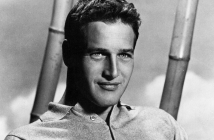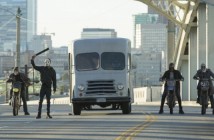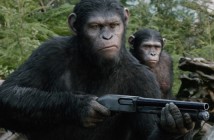10. It Don’t Worry Me: The Revolutionary American Films of the Seventies (2003) by Ryan Gilbey
“For most of us, irrespective of age, the movies of the past are not movies of the past at all. I hope this book will be a reminder of that…If there is one thing that most of these movies have in common, beyond the nationality of their creators, beyond the role they played in advancing cinema, it is that their power remains undimmed.”
The former lead critic of Premiere UK and now of The New Statesman, Ryan Gilbey reevaluated some of the major directors of the so-called New Hollywood of the 1970s in It Don’t Worry Me, title taken from a song in Robert Altman’s Nashville. Limiting himself to ten of the foremost auteurs of the era, Gilbey’s blatantly idiosyncratic tastes embrace Demme but not Bogdanovich, De Palma but not Friedkin, Kubrick but not Ashby. Yet whether one agrees with his particular opinions or not, his book does what an examination unencumbered by nostalgia or preconceived notions should do: force one to feel the immediate need to review and uncover the insights that are delivered with such stylish illumination. While close reading the directors’ films of this particular decade, he also fruitfully traces lines backward and forward, especially back toward Roger Corman and forward toward the heavily influenced likes of Paul Thomas Anderson, Spike Jonze, and Wes Anderson. Gilbey’s breathless, enthusiastic prose can equally capture the phantasmagoria of Close Encounters of the Third Kind, the horrors of Barry Lyndon, and the warmth of Demme’s output of the 1970s.
9. Movie Mutations: The Changing Face of World Cinephilia (2003) edited by Jonathan Rosenbaum and Adrian Martin
“And with community comes dialogue, conversation. That’s why so much of this book takes the form of dialogues, letters or email exchanges. All these types of collaborative writing can create a different way of speaking and thinking about cinematic objects. Modes and tones get mixed, digression has a place, the personal voice is valued.”
As a film fan of the first Internet generation, it’s fascinating and exciting to read the wide range of correspondents and interviewees, whose letters and emails constitute Movie Mutations and who grapple with and interrogate the present and future of a truly global cinephilia. Critics, writers, programmers, and historians from the US, Australia, Austria, Argentina, Canada, France, Japan, and elsewhere model a form of international communication on a variety of subjects, from the possibility of reconciling academic with journalistic film studies to how certain filmmakers are received and evaluated in both their home countries and abroad. Several of my favorite contemporary writers on film, not least among them the co-editors, make appearances to tout their favorite filmmakers and give well-informed, situated reports on the state of film culture in their home base nations. My life within the wider film culture basically began through the Internet and its cinephilic message boards and social media, for which Movie Mutations is an influential, early illustration.
 8. Acting in the Cinema (1988) by James Naremore
8. Acting in the Cinema (1988) by James Naremore
“‘Performance’…is understood in its broadest, most social, sense, as what we do when we interact with the world - a concept embracing not only theater but also public celebrity and everyday life. In its own brief, modest, and quite different way, Kid’s Auto Race has similar implications: after all, comic theatrical performance has always been designed to expose and make fun of our social roles, and Chaplin was one of its masters.”
One of the best straddlers between the worlds of academic and popular film writing is retired Indiana University professor James Naremore, maybe best known for the panoramic More Than Night: Film Noir in Its Contexts. A decade before that work and a decade after The Magic World of Orson Welles came Acting in the Cinema, an eminently readable look at various acting styles and individual performances in the history of movies with a healthy and elegantly-deployed dollop of film and social theories, most notably those of sociologist Erving Goffman who compared regular human interactions with theatrical and dramatic performances. After assailing the illusion of “naturalism” in film acting and, even further, the ideological conception of the unified self in everyday life, Naremore closely examines a choice list of “star” performances, including Lillian Gish in True Heart Susie, Marlene Dietrich in Morocco, and Cary Grant in North by Northwest, finally finishing by working through the various acting styles at play in both Rear Window and The King of Comedy. It’s a groundbreaking and eye-opening mix of theory and practice.
7. Figures Traced in Light: On Cinematic Staging (2005) by David Bordwell
“Originality emerges when a filmmaker creatively fits a new means to a recognized end, or decides on new goals that rework an old means.”
My thirst for formalist analysis of cinema can always be sated by revisiting the work of David Bordwell, whose textbooks with Kristin Thompson should be familiar to film students throughout the world. Few writers on film are more attentive to the ways in which filmmakers construct and stage their cinematic universes, so it should be no surprise that I choose to celebrate Figures Traced in Light, his survey of four master directors’ methods of composing the frame with people, objects, and movement. In opposition to what he’s famously labeled as the “intensified continuity” of modern Hollywood aesthetics, and in extension of his earlier On the History of Film Style, Bordwell takes as his representative cases the French silent-era Louis Feuillade, the Japanese creator of elegant mise-en-scène Kenji Mizoguchi, the Greek filmmaker most famous for long takes Theo Angelopoulos, and the Taiwanese examiner of history and modernity Hou Hsiao-hsien. Anyone interested in any of these directors or in strategies of cinematic arrangement should visit and revisit Bordwell’s far-reaching work.
6. Something Like an Autobiography (1983) by Akira Kurosawa, translated by Audie Bock
“I don’t really like talking about my films. Everything I want to say is in the film itself…If what I have said in my film is true, someone will understand.”
Many filmmaker autobiographies and critical treatises are indispensable (off the top of my head, My Last Sigh, Million Dollar Movie, Notes on the Cinematographer, Making Movies, and Sculpting in Time come to mind), but Akira Kurosawa’s Something Like an Autobiography, with its seemingly offhand title, at this moment seems dearest to me. Even for someone encountering it for the first time, it may seem fitting that so late in his life, Kurosawa would choose to write personally and perceptively on his earliest years, from birth until the development in 1950 of his Western breakthrough Rashomon, although diehard fans of his may want insights into the career beyond. Much emotion comes from his evident adoration of his older brother Heigo, a thoroughly Kurosawan character of intellect and passion, who ushered Akira into foreign literature and moved him closer to movies by becoming a benshi (Japanese silent film narrator). Kurosawa never stints from detailing his own personal failings or gripes about his industry (most ire reserved for the censors), and his account of his early life is a fitting analogue to the oceanic ranges of emotion and philosophy present in his own films.
5. Defining Moments in Movies: The Greatest Films, Stars, Scenes, and Events that Made Movie Magic (2007) edited by Chris Fujiwara
“At every page of this book the reader will meet different criteria for choosing moments and different reasons to appreciate them…The aim of this strategy was…to bring into play a variety of positions. Just as the people sleeping in Tokyo trains in Sans soleil dream together the “ultimate film”…so this book might be read as a collective dream of film.”
The 800-page, rectangular block of cinematic erudition that is Defining Moments in Movies is, like Richard Roud’s Cinema: A Critical Dictionary and David Thomson’s A Biographical Dictionary of Film, an essential reference guide and endlessly readable. With a style like the former and idiosyncrasies like the latter, the collaboration between editor Chris Fujiwara and over sixty other contributors collects capsule reviews of individual films, people, events, and scenes from the whole of cinema history, ranging in chronology from the commercial debut of Lumière shorts to a smoky tryst in Tsai Ming-liang’s I Don’t Want to Sleep Alone. Its greatest strengths lie in the knowledge and variety of contributors and choices culled from all around the world and all three levels of brow: Andy Warhol’s Empire and Jerry Lewis’s The Patsy are examined on the same page, for instance. I bet I can guarantee that no one has seen absolutely everything referenced in the book, making it a superb recommendation tool as well as a compelling compendium of bite-sized illuminations and insights.
4. From Reverence to Rape: The Treatment of Women in the Movies (1974, reissued in 1987) by Molly Haskell
“The anomaly that women are the majority of the human race, half of its brains, half of its procreative power, most of its nurturing power, and yet are its servants and romantic slaves was brought home with peculiar force in the Hollywood film. Through the myths of subjection and sacrifice that were its fictional currency and the machinations of its moguls in the front offices, the film industry maneuvered to keep women in their place; and yet these very myths and this machinery catapulted women into spheres of power beyond the wildest dreams of most of their sex.”
Exceedingly influential, Molly Haskell’s dissection of various cinematic treatments of women remains relevant because she considered herself “a film critic first and a feminist second,” sensitive to the star powers of actresses and auteurism-inflected knowledge of film history by way of filmmakers and personalities. While for the most part critical of Hollywood’s ghettoization of female agency to the so-called “women’s film,” full of domestic limits, self-sacrifice, and tragedy, Haskell singled out the likes of Bette Davis, Rosalind Russell, and Katharine Hepburn as examples of both the “extraordinary woman” and the “ordinary woman who becomes extraordinary” by transcending victimhood. The 1987 updated edition brings her analysis more further up to date, but it’s in her examination of the highs and lows of Hollywood’s feminine imagery that From Reverence to Rape did and will continue to foster critical thinking about gender in cinema.
3. Agee on Film: Criticism and Comment on the Movies (1948, reprinted by Modern Library in 2000) by James Agee
“I suspect that I am, far more than not, in your own situation: deeply interested in moving pictures, considerably experienced from childhood on in watching them and thinking and talking about them…It is my business to conduct one end of a conversation, as an amateur critic among amateur critics. And I will be of use and of interest only in so far as my amateur judgment is sound, stimulating or illuminating.”
Little can be said that hasn’t been already about this collection of weekly reviews for Time and articles for The Nation by poet-screenwriter James Agee, one of the patron saints of journalistic film criticism. Reading the sections in chronological order is perhaps more rewarding than devouring individual reviews, if only because this process delivers insight into Agee’s workaday life as a film reviewer in addition to his published thoughts on film after film. It’s bracing to see him grapple with both the acknowledged classics and now-forgotten detritus produced in Hollywood and abroad during his stint for Time, his rich prose in the service of attack against the phony piety and patriotism he noted in the war and postwar years, and in defense of the humanist-realist tradition he noted in the work of Rossellini, for example. But Agee also has some rousing standalone moments, taking three columns to tackle Monsieur Verdoux and writing some of the most perceptive articles of the time on D.W. Griffith and silent comedy.
2. The American Cinema: Directors And Directions 1929-1968 (1968) by Andrew Sarris
“The transcendental view of the auteur theory considers itself the first step rather than the last stop in a total history of the cinema. Eventually we must talk of everything if there is enough time and space and printer’s ink. The auteur theory is merely a system of tentative priorities, a pattern theory in constant flux.”
In terms of giving me a list of to-watch priorities and shaping my own evaluative criteria for movie-watching, no single volume approaches Andrew Sarris’s seminal 1968 execution of the auteur theory on Hollywood history, itself an outgrowth of a Film Culture article published five years earlier. Book-ended by elucidations and defenses of his personal brand of auteurism, the bulk of the book is a hierarchical and categorized journey through major filmmakers of Hollywood’s past, present, and perhaps future; part of the fun and amiable frustration of going back to The American Cinema lies in absorbing Sarris’s 1968 perspective on such developing heavyweights as Stanley Kubrick, Sam Peckinpah, John Cassavetes, and Francis Ford Coppola. Choice morsels of the author/auteur’s witty, frequently alliterative, insightful prose abound, such as describing John Boorman’s Point Blank as “treading over the slick surfaces of evil with the squeaky shoes of morality.” Sarris famously reversed himself on casting Billy Wilder into the dreaded “Less than Meets the Eye” category, but in The American Cinema, Sarris may have underrated but he never overrated.
 1. The Material Ghost: Films and Their Medium (1998) by Gilberto Perez
1. The Material Ghost: Films and Their Medium (1998) by Gilberto Perez
“The projector, the magic lantern, animates the track of light with its own light, brings the imprint of life to new life on the screen. The images on the screen carry in them something of the world itself, something material, and yet something transposed, transformed into another world: the material ghost.”
Sarah Lawrence College film professor Gilberto Perez, contributor to the London Review of Books, Sight & Sound, and many other periodicals, published his first full-length book in 1998 (paperback in 2000), pouring an entire career’s worth of thought and insight into a densely readable investigation of a wide range of cinema. One of my favorite aspects of Perez’s tome is the elegant way in which he navigates the traditional dichotomies of film discourse - narrative vs. non-narrative, fiction vs. documentary, nature vs. artifice, theory vs. experience - finding both at play in many of the films he chooses to explicate (such as those by Renoir, Kiarostami, Antonioni, Keaton, Murnau, and Staub/Huillet). Willfully eschewing trendy theoretical developments in the academy, he plunges into close readings of a variety of classic and modernist films with a mix of humanistic and aesthetic considerations, putting him in the Bazinian tradition even as Perez pushes against the boundaries of the Frenchman’s, or anyone’s, totalizing theories on the “true nature” of cinema. Here’s hoping that Perez gives us another such well-articulated book in the future.



